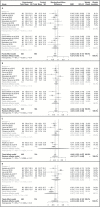A Meta-analysis of Retinal Cytoarchitectural Abnormalities in Schizophrenia and Bipolar Disorder
- PMID: 31112601
- PMCID: PMC6942159
- DOI: 10.1093/schbul/sbz029
A Meta-analysis of Retinal Cytoarchitectural Abnormalities in Schizophrenia and Bipolar Disorder
Abstract
Background: Schizophrenia (SZ) and bipolar disorder (BD) are characterized by reductions in gray matter and white matter. Limitations in brain imaging have led researchers to use optical coherence tomography (OCT) to explore retinal imaging biomarkers of brain pathology. We examine the retinal layers that may be associated with SZ or BD.
Methods: Articles identified using PubMed, Web of Science, Cochrane Database. Twelve studies met inclusion for acutely/chronically ill patients. We used fixed or random effects meta-analysis for probands (SZ and BD), SZ or BD eyes vs healthy control (HC) eyes. We adjusted for sources of bias, cross-validated results, and report standardized mean differences (SMD). Statistical analysis performed using meta package in R.
Results: Data from 820 proband eyes (SZ = 541, BD = 279) and 904 HC eyes were suitable for meta-analysis. The peripapillary retinal nerve fiber layer (RNFL) showed significant thinning in SZ and BD eyes compared to HC eyes (n = 12, SMD = -0.74, -0.51, -1.06, respectively). RNFL thinning was greatest in the nasal, temporal, and superior regions. The combined peripapillary ganglion cell layer and inner plexiform layer (GCL-IPL) showed significant thinning in SZ and BD eyes compared to HC eyes (n = 4, SMD = -0.39, -0.44, -0.28, respectively). No statistically significant differences were identified in other retinal or choroidal regions. Clinical variables were unrelated to the RNFL or GCL-IPL thickness by meta-regression.
Conclusion: The observed retinal layer thinning is consistent with the classic gray- and white-matter atrophy observed on neuroimaging in SZ and BD patients. OCT may be a useful biomarker tool in studying the neurobiology of psychosis.
Keywords: bipolar disorder; choroid thickness; ganglion cell layer; macula volume; optical coherence tomography; retinal nerve fiber layer thickness; schizophrenia.
© The Author(s) 2019. Published by Oxford University Press on behalf of the Maryland Psychiatric Research Center. All rights reserved. For permissions, please email: journals.permissions@oup.com.
Figures




References
-
- Tamminga CA, Ivleva EI, Keshavan MS, et al. . Clinical phenotypes of psychosis in the Bipolar-Schizophrenia Network on Intermediate Phenotypes (B-SNIP). Am J Psychiatry. 2013;170(11):1263–1274. - PubMed
Publication types
MeSH terms
LinkOut - more resources
Full Text Sources
Medical
Miscellaneous

